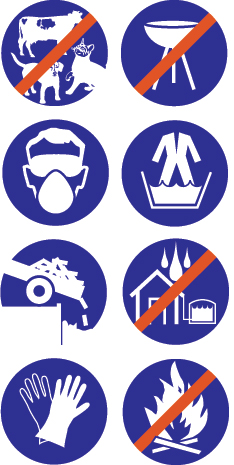Important Information About Lifewood CCA
Please note: CCA treated timber has some limitations to its use within the Australian market. CCA treated timber cannot be used for garden furniture, picnic tables, exterior seating, children’s play equipment, patio and domestic decking, and hand rails. Alternative treatments such as Naturewood ACQ and Protim Optimum are approved for use in these applications, Osmose recommends either of these preservative options as suitable alternatives.
Wood treated with inorganic arsenic should be used only where such protection is important.
Inorganic arsenic penetrates deeply into and remains in the pressure-treated wood for a long time. However, some chemical may migrate from treated wood into surrounding soil over time and may also be dislodged from the wood surface upon contact with skin. Exposure to inorganic arsenic may present certain hazards. Therefore, the following precautions should be taken both when handling the treated wood and in determining where to use or dispose of the treated wood.
Use Site Precautions
All sawdust and construction debris should be cleaned up and disposed of after construction.
Do not use treated wood under circumstances where the preservative may become a component of food or animal feed. Examples of such sites would be use of mulch from recycled arsenic-treated wood, cutting boards, counter tops, animal bedding, and structures or containers for storing animal feed or human food.
Only treated wood that is visibly clean and free of surface residue should be used for patios, decks and walkways. Do not use treated wood for construction of those portions of beehives which may come into contact with honey. Treated wood should not be used where it may come into direct or indirect contact with drinking water, except for uses involving incidental contact such as docks and bridges.
Handling Precautions
Dispose of treated wood by ordinary trash collection. Treated wood should not be burned in open fires or in stoves, fireplaces, or residential boilers because toxic chemicals may be produced as part of the smoke and ashes. Treated wood may be burned only in commercial or industrial incinerators or boilers in accordance with national and / or state and Federal regulations.
Avoid frequent or prolonged inhalation of sawdust from treated wood. When sawing, sanding and machining treated wood, wear a dust mask. Whenever possible, these operations should be performed outdoors to avoid indoor accumulation of airborne sawdust from treated wood.
When power-sawing and machining, wear goggles to protect eyes from flying particles.
Wear gloves when working with wood. After working with wood, and before eating, drinking, toileting, and use of tobacco products, wash exposed areas thoroughly.
Because preservatives or sawdust may accumulate on clothes, they should be laundered before re-use. Wash work clothes separately from other household clothing.

Hazard Class
Please view our Australia hazard class system guide below to explore the different hazard classes and the approved Koppers systems used.
